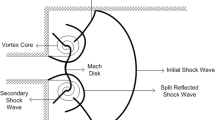Abstract
Recently, micro shock tubes have been widely used in various fields such as aerospace, combustion and medical science. Needle-free drug delivery device is a typical example of the application of the micro shock tube used in the field of medical science. Compared to the macro shock tube, the flow viscosity and micro scale effects considerably influence the shock wave propagation in the micro shock tube, which makes shock wave behaviors significant difference from the theoretical prediction. Boundary layers which develop behind the moving shock wave attenuate the shock wave propagation as well. Additionally, the gas-particle flows are also shown the different characteristics compared to the single gas flow in the micro shock tube. Particles are induced by the shock wave inside the micro shock tube and accelerated in the supersonic nozzle. Supersonic flows and particle velocity make experimental studies difficult to be performed in the micro shock tube. Even though micro shock tubes have been studied for decades, shock flow characteristics and particle dynamics inside the micro shock tube are not well known to date. For the present study, pressure measurements and optical visualization have been carried out in a micro shock tube. Static pressure measurements were used for investigating the shock wave propagation in the driven section, and Pitot pressure measurements were used for obtaining flow characteristics at the exit of nozzles. Two high sensitive pressure transducers were used for recording pressure changes as the shock wave moved through pressure transducers and the shock Mach number was calculated. Particle tracking velocimetry was conducted to analyze particle-gas two-phase flows. Particle distribution and velocity were obtained in the present experiment study.
Graphical abstract















Similar content being viewed by others
References
Duff RE (1959) Shock tube performance at initial low pressure. Phys Fluids 2(2):207–216
Fincher JH (1968) Particle size of drugs and its relationship to absorption and activity. J Pharm Sci 57(11):1825–1835
Higashino F, Matsuo S, Tsuyuki T (1991) Oscillation of oblique shock waves generated in a two dimensional asymmetric nozzle. SAE Transactions 100(2):2254–2262
Hu X, Aoki T, Tokura N (2012) The feature of weak shock wave propagated in an overlong tunnel. Open J Fluid Dyn 2(4):285–289
Kendall MAF (2002) The delivery of particulate vaccines and drugs to human skin with a practical hand-held shock tube-based system. Shock Wave 12(1):23–30
Kendall MAF, Quinlan NJ, Thorpe RW, Anisworth SJ, Bellhouse BJ (2004) Measurements of the gas and particle flow within a converging-diverging nozzle for high speed powdered vaccine and drug delivery. Exp Fluids 37(1):128–136
Li JH, Kwauk M (1994) Particle-fluid two-phase flow. Metallurgical Industry Press, Beijing
Liu Y (2006) Performance studies of particle acceleration for transdermal drug delivery. Med Biol Comput 44(7):551–559
Liu Y, Kendall MAF, Truong NK, Bellhouse BJ (2002) Numerical and experimental analysis of a high speed needle-free powdered vaccines delivery device. In: 20th AIAA applied aerodynamics conference, St. Louis, Missouri, pp 1–11
Luo X, Wang G, Oliver H (2008) Parametric investigation of particle acceleration in high enthalpy conical nozzle flows for coating applications. Shock Waves 17(5):351–362
Mcbride DD (1971) Pitot pressure in hypersonic flow with condensation. AIAA J 9(12):2354–2357
Park JO, Kim GW, Kim HD (2014) Experimental study of the shock wave dynamics in micro shock tube. J Korean Soc Propuls Eng 17(5):54–59
Quinlan NJ, Kendall MAF, Bellhouse BJ, Anisworth RW (2001) Investigation of gas and particle dynamics in first generation needle-free drug delivery device. Shock Wave 10(6):395–404
Raghunath A, Mee DJ, Roesgen T, Jacobs PA (2004) Visualization of supersonic flows in shock tunnels using the background oriented schlieren technique. In: AIAA Australian aerospace student conference 2004. University of Sydney, Australia
Smith CE (1966) The starting process in a hypersonic nozzle. J Fluid Mech 24(4):625–641
Sun M, Ogawa T, Takayama K (2001) Shock propagation in narrow channels. In: Processing of 24th international symposium on shock waves, Beijing, China, pp 1321–1327
Sutcliffe MA, Morgan RG (2001) The measurement of Pitot pressure in high enthalpy expansion tubes. Meas Sci Technol 12(3):327–334
Acknowledgments
This work was supported by the National Research Foundation of Korea (NRF) grant funded by the Korea government (MEST) (NRF-2011-0017506).
Author information
Authors and Affiliations
Corresponding author
Rights and permissions
About this article
Cite this article
Zhang, G., Lee, I., Hashimoto, T. et al. Experimental study on gas-particle two-phase flows in a micro shock tube. J Vis 20, 17–29 (2017). https://doi.org/10.1007/s12650-016-0364-8
Received:
Revised:
Accepted:
Published:
Issue Date:
DOI: https://doi.org/10.1007/s12650-016-0364-8



